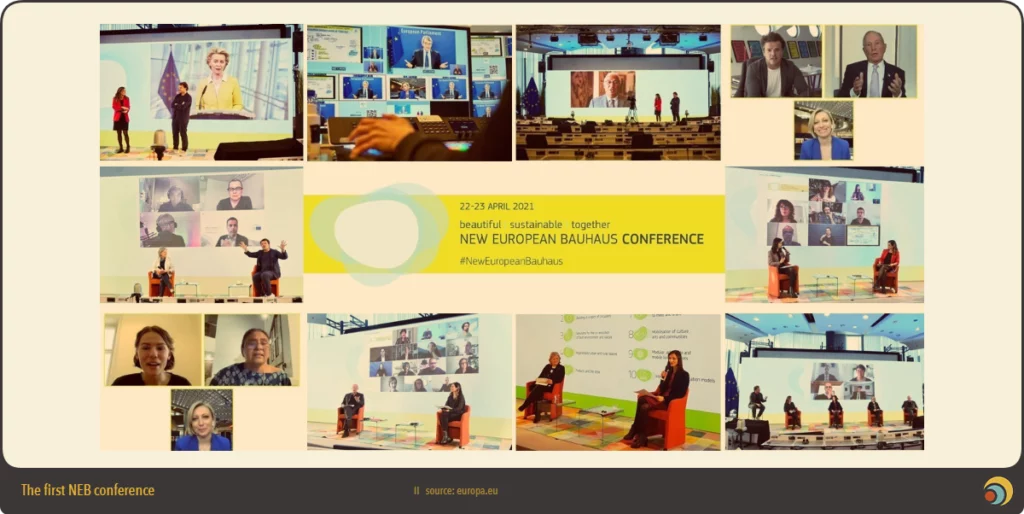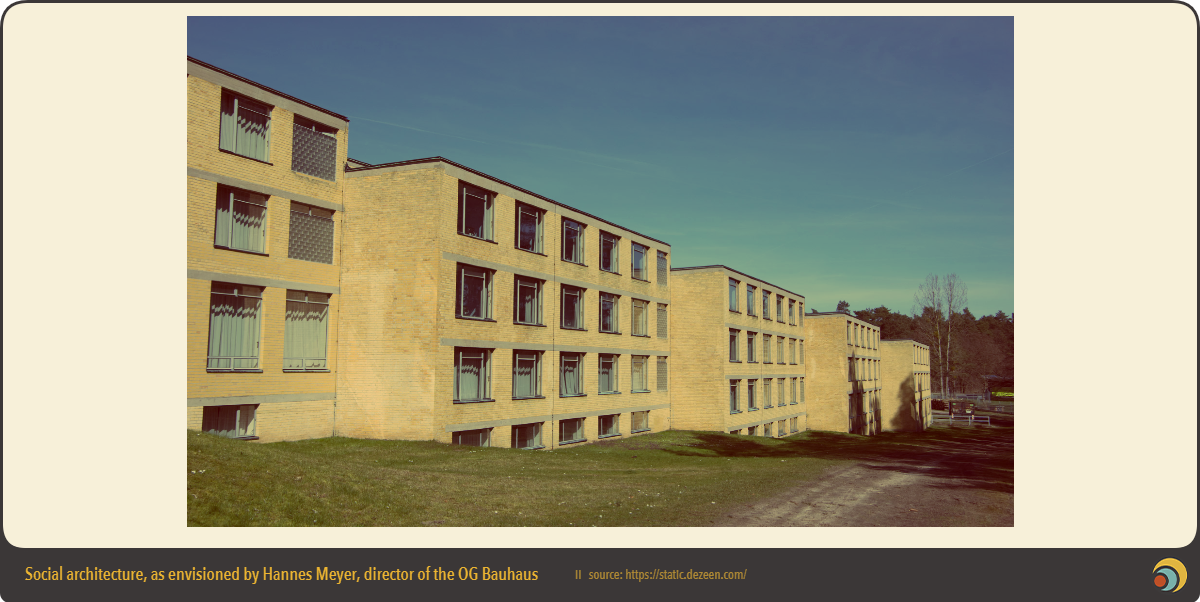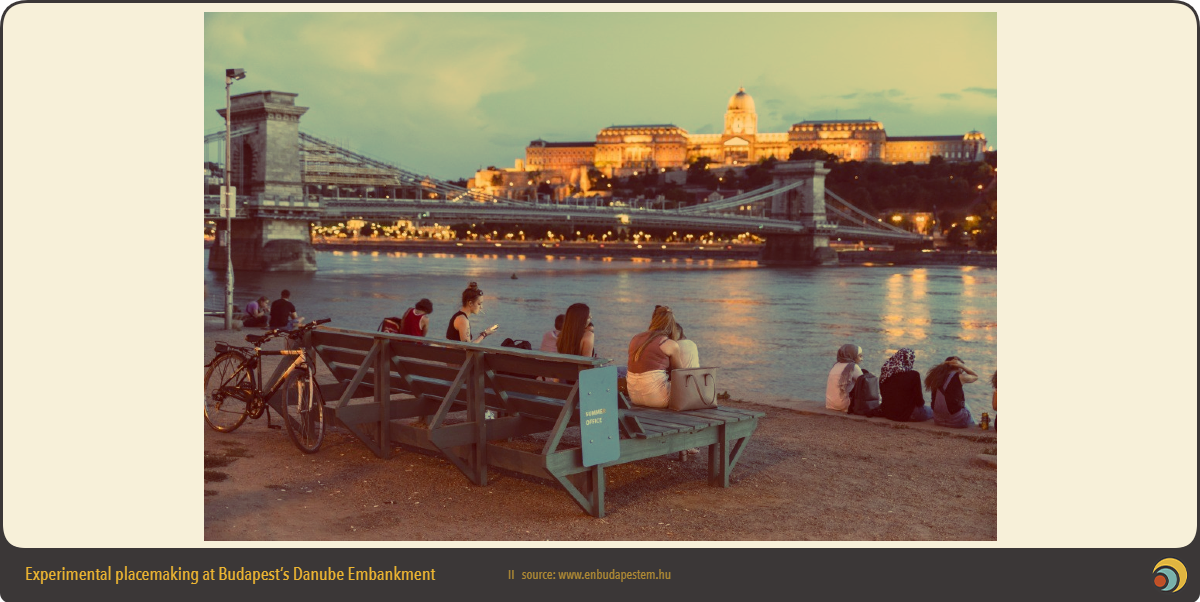New European Bauhaus is an exciting new initiative – or shall we say movement – of the EU that was announced in 2021. To understand NEB better, we turned to Eszter Dávida, from Contemporary Architecture Centre Budapest (KÉK), who sits on the high level round table of NEB, together with some of the most important activists, artists and architects of the world.
What is the New European Bauhaus?
Eszter Dávida: In a sentence, it is an aspiring movement, set up by the European Commission. Ursula von der Leyen’s political programme included a pledge that, before the EU starts to invest in earnest, in the new 2021-27 period, we should take a step back, and rethink how we would like to live in Europe, in what kinds of cities and in what kinds of environments. New European Bauhaus frames this, seeking answers for all challenges that we consider important today, from the climate and energy crises to housing and migration.

There are two things that are unclear to me. First, while I understand how NEB is a movement, I have always wondered how it will manifest in concrete actions, policies, projects and so on. The second is that I find the idea of making green transition beautiful and aesthetic a little elusive.
About a year and a half ago, when they started creating NEB, one of the points was to reach as many people as possible. For this end, the Commission decided to make NEB into a participative, movement-like initiative. This meant that for the three topics (sustainability, inclusivity, aesthetics) everyone was able to send in their views on the challenges, problems as well as their good practices. And by “everyone”, I mean everyone, not just specialist organisations, but also citizens. This was interesting because this was the first time the Commission did a procedure like this on this scale.
They collected thousands of good practices. In the last period, they started thinking about what to mobilise in order to build up the NEB. For example, there are periodic calls for partner institutions (organisations (including informal organisations) can join the movement as partners and can work as part of international working groups on various topics), they started the New European Bauhaus Awards to put smaller scale, bottom initiatives fitting the NEB into the spotlight. There is an NEB Festival where we as KÉK, too, participated as well with an event on placemaking in the context of exploring better uses of the Danube Embankments.
Finally, NEB established a round table of 18 experts (including award-winning architect Shigeru Ban and Bjarke Ingels), which I am part of. We were tasked with writing a concept paper on the challenges and foci on the three topics (sustainability, inclusivity, aesthetics) to make them more concrete. We also make proposals directly to von der Leyen, to highlight areas where the EU wouldn’t normally concern itself but should intervene.
From last autumn, based on our concept paper naming concrete areas and challenges, they started to include NEB-themed calls into existing EU funding programmes. So as NEB is becoming more and more concrete, it becomes clearer and clearer what interventions in, say, sustainability serve NEB-values the best and funding programmes will be adapted accordingly.
Creating a platform for organisations working on similar issues is already a big achievement. For example, someone working on things such as alternative programmes for children can join an international network discussing the greatest challenges in education. Such open discussions in such informal setups are unprecedented.
A good outcome of NEB would be, for example, a toolbox for designing city centres. The superblock model in Barcelona is a good example of this, creating pedestrian and communal spaces.
Can you explain what it means for NEB to be sustainable, inclusive and aesthetic?
The crucial question for NEB is: what kind of cities would we like to live in in the future? Most people live in built-up environments, and the quality of buildings and urban environments affects all.
NEB does not have a pre-set answer, but rather NEB collects answers from all over Europe that it merges into a cohesive vision.
On our side, the answer that we came up within the frame of the expert round table is presented in the concept paper. For example, in terms of sustainability, it was often raised that the fundamental question should be if it is possible not to build. Each month, we build up areas the size of Manhattan – and the question is, do we want to support this? Another issue is the materials we use. For example, for fire hazards, organic materials are hard to be used in construction. Regulations therefore should be changed. Now, an EU committee is considering how regulation could be changed.
For inclusivity, we discussed that we should be better in disseminating new solutions better. This is a problem not only in Hungary, but all over Europe and the world. Education is also key to inclusivity. We need education to be prepared for future changes and built-up (and natural) environments should be present in education in a different way. We also need different ways to educate.
Recreational spaces are also key. In relation to that, we need to discuss whether the lives we live are good lives. We need to give new meanings for often overused phrases such as “mental health” or “sustainability”, in order to create better lives and built environments to fit them.
Finally, beauty itself should be rethought, in order to fit our age better. This is true in architecture, design, but also in interpersonal relationships. Tolerance and solidarity should be key aspects of discussing aesthetics and beauty. Not only glass walls and what we normally think of as contemporary architecture can be beautiful. This, too, might be important for the green transition.
The movement, of course, is named after Bauhaus, but I’m unsure how the two compare. First, how ‘school-like’ is NEB compared to the ‘OG’ Bauhaus? How much is there an aspiration to train future urbanists, policy-makers, architects, or even artists? Second, how much is there an aspiration to match contemporary architecture to the contemporary world and technology? Third, how much is there a focus on sensibility to social challenges as there was at the Bauhaus especially under Hannes Meyer?
Well, NEB relates to the original Bauhaus not in content but in its aspirations to change society. Bauhaus transformed the architecture of the 20th century wholesale, impacting our lives even today. A similar transition is needed with the climate crisis, the challenges to our built environment (such as energy issues), or sustainability as its most immediate targets, but the goal is to transform everything related to our urban infrastructures: inequalities, migration, housing, the economy, jobs, etc.
Instead of being school-like, the movement is inclusive. As our urban environments impact us all, it is key that not only architects and urbanists, but also non-expert citizens are involved in a movement that sets about to rethink them. This also includes citizens from all over Europe, including from rural and less affluent communities. Social change will only happen if a large number of people recognises that change is needed.Mindset changes, too, require large crowds.
Therefore, it is key to deliver NEB messages to all social groups. This, however, is only at the beginning. And it would be great if NEB could be integrated into the educational system.
And what about social architecture, social housing, constructions to alleviate the housing crisis, accessibility – to what degree are these present in NEB?

The goal is to improve all of these. However, there is no good answer on what are the tools developed to achieve these goals. We, the 18 members of the round table, have discussed in detail that even within Europe, challenges differ between various areas. Therefore, you cannot give a common answer to problems.
Again, the key is to rethink the normal barriers between various stakeholders in Europe, and I am optimistic that this will lead to positive change. But even if NEB fails, the collection of good practices is valuable in and of itself. We often cannot directly adapt a, say, Norwegian good practice here in Hungary. But looking at good practices in Ukraine or Romania or Slovenia can be more fruitful, as their circumstances are much more similar to ours.
And these good practices are present all over Europe, even if not widely known. In Hungary, we see a lot of good practices adapted in smaller settlements in rural areas, but due to their scale, they are overlooked. But if their scale could be changed or if the owners of the good practices know of each other, there could be a movement where various players in Europe can learn from each other. This could be an outcome of NEB, too. It would be amazing if Hungarian good practices were better available and known to a larger group of people. If there is a platform of good practices, those wanting to build a house can go there.
Could you give some examples of good practices?
Everyone was able to send in good practices, and we, too, sent some we knew of. For example, opening up the Danube Embankments for pedestrians and micro mobility is a good practice from Budapest.

During the covid crisis, we rethought how we use public and private space. Public spaces can have temporary functions. We can use streets for vehicle traffic during the day, but as playgrounds during the evening or weekends. We can declare that a street is for cyclists only from 8 til 2. There are examples for so-called play streets in Berlin, but even in Budapest, these existed around WW2. This doesn’t require much infrastructure.
There are many community-built small-scaled projects in Hungary, that we also raised to NEB. There are many examples for alternative modes of construction that are sustainable (e.g., sustained by the community), co-design, objects making alternative lives possible, greening. There was an NEB Award winner from Hungary, too.
And my last question: how did you end up on the NEB roundtable?
At the beginning of last year, the Commission was looking for experts to create a diverse roundtable with people of various ages, backgrounds, expertises, genders, etc. They contacted me via KÉK. There were a couple of rounds of interviews, but it wasn’t yet clear that we will assist Ursula von der Leyen. I think I was approached because KÉK has a couple of EU projects, such as DANUrB which I was part of. There, we focused on Danube-side smaller towns and villages, and how local communities could be turned into networks to highlight local values.
They selected 18 of us. It includes an 18 year old climate activist, sitting with a celebrity architect, with one of the project managers of Barcelona Superblock. This allows it to channel different social needs. It would have been much worse to have 20 architects or an EU committee. This same principle is also present on lower levels, and should eventually appear in all programmes.
This also allows us to channel in views that, for obvious reasons, don’t normally appear at EU level. At the round table, there is, for example, an Indian activist openly criticising the EU for its migration policies and elitism. I believe that EU funding is key for the development of Hungary, but should be criticised for insufficiently targeting vulnerable groups. NEB allows us to talk about this and to discuss solutions to the problems we brought up.

This month, we talked to Eszter Dávida, a member of the High Level Roundtable of New European Bauhaus: beautiful, sustainable, together.
Eszter is an urbanist who focuses on the shaping of inclusive and sustainable cities through the lenses of technology and the local communities. She graduated as an architect at Budapest University of Technology and Ecomomics in 2016. Apart from architecture, her areas of interest are activism, community building, methodology research and education. Her biggest challenge is to find working solutions between bottom-up and top-down approaches. She founded several organizations related to education about contemporary architecture, urban and design questions; she has 15 years of experience in this field. She joined KÉK Kortárs Építészeti Központ – Hungarian Contemporary Architecture Center in 2007 as a volunteer. Currently she is a director of KÉK and leads Pecha Kucha Night Budapest and the DANUrB+ (Interreg – Danube Urban Brand) program, where she focuses on fostering local communities to participate in urban networks on a regional and international scale. She also works as an architect on data-driven urban planning projects. In 2021 she was chosen to be part of the New European High Level Roundtable – an independent committee of interdisciplinary experts from Europe.
